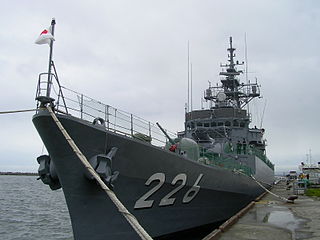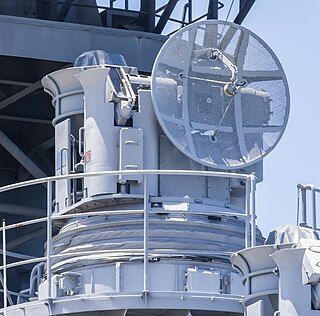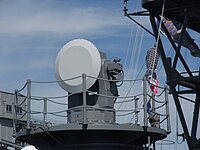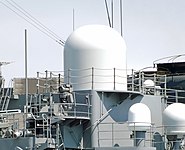
The Kongō class of guided-missile destroyers in the Japan Maritime Self-Defense Force are equipped with the Aegis Combat System, and is the first of few ship classes outside the United States to have that capability. Following a decision made in December 2003, Japan is upgrading their Kongo-class destroyers with Aegis Ballistic Missile Defense System. The upgrade involves a series of installations and flight tests to take place from 2007 to 2010. JS Kongo was the first ship to have the BMD upgrade installed.

The Hatsuyuki-class destroyer is a class of destroyer, serving with the Japan Maritime Self-Defense Force (JMSDF). It was the first class of first generation of general-purpose destroyers of the JMSDF.

The Asagiri-class destroyer is a class of destroyer, serving with the Japan Maritime Self-Defense Force (JMSDF). It was the second class of first-generation general-purpose destroyers of the JMSDF.

JS Ishikari (DE-226) was the first destroyer escort with a gas turbine engine and surface-to-surface missiles of the Japanese Maritime Self-Defense Force. She is the successor of the earlier Chikugo class. Entering service in 1981, she remained active until 2007 when she was decommissioned.

The Abukuma-class destroyer escort is the general-purpose destroyer escort of the Japan Maritime Self-Defense Force. It is the successor of the earlier Yūbari class.

The Chikugo-class destroyer escort was a class of destroyer escorts built by the Japanese Maritime Self-Defense Force as the successor of the Isuzu class, with the same ASW mission. This class was followed by JDS Ishikari. This is the first Japanese destroyer escort class to carry ASROC anti-submarine missiles.

JS Mineyuki (DD-124) was a Hatsuyuki-class destroyer of the Japanese Maritime Self-Defense Force.

JS Kurama (DDH-144) was the second ship of the Shirane-class destroyer in service with the Japan Maritime Self-Defense Force (JMSDF).

JS Hatsuyuki (DD-122) was the lead ship of the Hatsuyuki-class destroyers.

FCS-1 was a Japanese ship gun fire-control system (GFCS).

JS Hamayuki (DD-126) was a Hatsuyuki-class destroyer of the Japanese Maritime Self-Defense Force.

JS Isoyuki (DD-127) was a Hatsuyuki-class destroyer of the Japanese Maritime Self-Defense Force.

JS Haruyuki (DD-128) was a Hatsuyuki-class destroyer of the Japanese Maritime Self-Defense Force.

JS Setoyuki (DD-131/TV-3518) was a Hatsuyuki-class destroyer of the Japanese Maritime Self-Defense Force.

JS Asayuki (DD-132) was a Hatsuyuki-class destroyer of the Japanese Maritime Self-Defense Force.

JS Shimayuki (DD-133/TV-3513) was a Hatsuyuki-class destroyer of the Japanese Maritime Self-Defense Force.

OPS-14 is a two-dimensional radar manufactured by Mitsubishi Electric. It is mainly mounted on the Maritime Self-Defense Force's self-defense ship as an anti-aircraft search radar. Variations include OPS-14B and OPS-14C.

OPS-18 is a two-dimensional radar manufactured by Japan Radio Company. It is installed as an anti-water search radar on the Maritime Self-Defense Force's escort ship. Variations include OPS-18-1 and OPS-18-3.

OPS-28 is a Pulse-Doppler radar manufactured by Japan Radio. It is installed as a low-altitude warning / anti-water search radar mainly on the Maritime Self-Defense Force's escort ship. Variations include OPS-28-1, OPS-28B, OPS-28C, OPS-28D, OPS-28E and OPS-28F.

Mark 63 Gun Fire Control System is a gun fire-control system made up of AN/SPG-34 radar tracker and the Mark 29 gun sight. They were usually equipped for the control of twin QF 4-inch naval gun Mk XVI and Mk.33 twin 3"/50 cal guns.






















